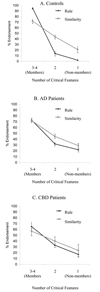Multiple systems of category learning
- PMID: 17904637
- PMCID: PMC2735458
- DOI: 10.1016/j.neubiorev.2007.07.009
Multiple systems of category learning
Abstract
We review neuropsychological and neuroimaging evidence for the existence of three qualitatively different categorization systems. These categorization systems are themselves based on three distinct memory systems: working memory (WM), explicit long-term memory (explicit LTM), and implicit long-term memory (implicit LTM). We first contrast categorization based on WM with that based on explicit LTM, where the former typically involves applying rules to a test item and the latter involves determining the similarity between stored exemplars or prototypes and a test item. Neuroimaging studies show differences between brain activity in normal participants as a function of whether they are instructed to categorize novel test items by rule or by similarity to known category members. Rule instructions typically lead to more activation in frontal or parietal areas, associated with WM and selective attention, whereas similarity instructions may activate parietal areas associated with the integration of perceptual features. Studies with neurological patients in the same paradigms provide converging evidence, e.g., patients with Alzheimer's disease, who have damage in prefrontal regions, are more impaired with rule than similarity instructions. Our second contrast is between categorization based on explicit LTM with that based on implicit LTM. Neuropsychological studies with patients with medial-temporal lobe damage show that patients are impaired on tasks requiring explicit LTM, but perform relatively normally on an implicit categorization task. Neuroimaging studies provide converging evidence: whereas explicit categorization is mediated by activation in numerous frontal and parietal areas, implicit categorization is mediated by a deactivation in posterior cortex.
Figures






Similar articles
-
Alternative strategies of categorization.Cognition. 1998 Jan;65(2-3):167-96. doi: 10.1016/s0010-0277(97)00043-7. Cognition. 1998. PMID: 9557382 Review.
-
The case for implicit category learning.Cogn Affect Behav Neurosci. 2008 Mar;8(1):3-16. doi: 10.3758/cabn.8.1.3. Cogn Affect Behav Neurosci. 2008. PMID: 18405041 Review.
-
Sustained and transient neural modulations in prefrontal cortex related to declarative long-term memory, working memory, and attention.Cortex. 2007 Jan;43(1):22-37. doi: 10.1016/s0010-9452(08)70443-x. Cortex. 2007. PMID: 17334205
-
The neural basis for categorization in semantic memory.Neuroimage. 2002 Nov;17(3):1549-61. doi: 10.1006/nimg.2002.1273. Neuroimage. 2002. PMID: 12414293
-
The neural basis for novel semantic categorization.Neuroimage. 2005 Jan 15;24(2):369-83. doi: 10.1016/j.neuroimage.2004.08.045. Epub 2004 Dec 10. Neuroimage. 2005. PMID: 15627580
Cited by
-
Striatal and hippocampal entropy and recognition signals in category learning: simultaneous processes revealed by model-based fMRI.J Exp Psychol Learn Mem Cogn. 2012 Jul;38(4):821-39. doi: 10.1037/a0027865. J Exp Psychol Learn Mem Cogn. 2012. PMID: 22746951 Free PMC article.
-
The effect of encoding conditions on learning in the prototype distortion task.Learn Behav. 2017 Jun;45(2):164-183. doi: 10.3758/s13420-016-0252-z. Learn Behav. 2017. PMID: 27858279
-
Rule-based category learning in patients with Parkinson's disease.Neuropsychologia. 2009 Apr;47(5):1213-26. doi: 10.1016/j.neuropsychologia.2009.01.031. Epub 2009 Feb 2. Neuropsychologia. 2009. PMID: 19428385 Free PMC article. Review.
-
Human category learning 2.0.Ann N Y Acad Sci. 2011 Apr;1224:147-161. doi: 10.1111/j.1749-6632.2010.05874.x. Epub 2010 Dec 23. Ann N Y Acad Sci. 2011. PMID: 21182535 Free PMC article. Review.
-
Compensatory processing during rule-based category learning in older adults.Neuropsychol Dev Cogn B Aging Neuropsychol Cogn. 2016;23(3):304-26. doi: 10.1080/13825585.2015.1091438. Epub 2015 Sep 30. Neuropsychol Dev Cogn B Aging Neuropsychol Cogn. 2016. PMID: 26422522 Free PMC article.
References
-
- Allen SW, Brooks LR. Specializing the operation of an explicit rule. Journal of Experimental Psychology. 1991;120:3–19. - PubMed
-
- Ashby FG, Maddox WT. Human category learning. Annual Review of Psychology. 2005;56:149–178. - PubMed
-
- Baddeley AD. Working memory. Oxford: Oxford University Press; 1986.
-
- Beauchamp MS, Lee KE, Argall BD, Martin A. Integration of auditory and visual information about objects in superior temporal sulcus. Neuron. 2004;41:809–823. - PubMed
-
- Bozoki A, Grossman M, Smith EE. Can patients with Alzheimer's disease learn a category implicitly? Neuropsychologia. 2006;44:816–827. - PubMed
Publication types
MeSH terms
Grants and funding
LinkOut - more resources
Full Text Sources
Medical

